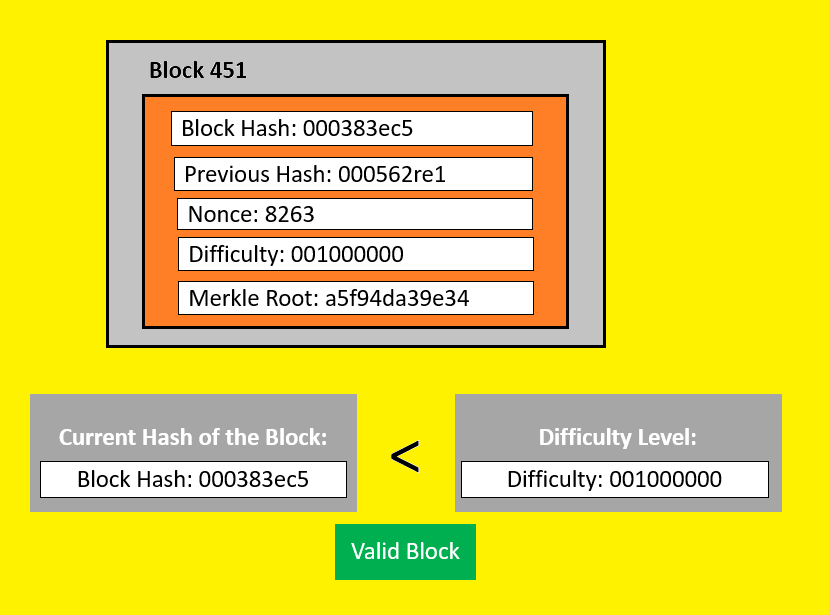Proof of Work (PoW) in the blockchain is a consensus mechanism that lets miners add a new block to the network based on the computation done to find the perfect hash. Network participants validate transactions added by the new block.
Introduction
For a decentralized network like Blockchain, it's crucial for keep all the network participants synchronized. Notwithstanding, it appears to be outlandish to cause everybody to settle on a certain something. Blockchain utilizes an consensus system to lay out administration among all the network participants. In this article, we'll go through one of the most well known and fundamental consensus protocols, i.e., Proof-of-Work (PoW) in the blockchain.
In
the first place, We should start by figuring out the consensus mechanism.
What is the
Consensus Mechanism?
In
basic terms, Consensus implies accomplishing a choice state with which all network
participants concur. For example, a gathering of companions consents to play
football without clashes. Here, to arrive at a choice to play football together
is a condition of consensus or shared understanding.
"The
reason for the Consensus mechanism in a blockchain is to permit a gathering of
discrete nudes to convey the option to refresh the network or framework. Be
that as it may, the update will occur as per a couple of laid out rules among
the set of participants in a solid manner."
In
the case of Blockchain, it structures somewhere around 51% of nudes or participants
in the network settle on the forthcoming change. Assuming it works out, the network
will refresh with the new change. Else, it dismisses the change by mutual consensus
Now,
let’s jump to the focus of the article, i.e., Proof-of-Work (PoW).
What is Proof
of-Work (PoW)?
Proof
of-Work (PoW) consensus mechanism is the most established at this point
generally famous. The thought previously popped in 1993 when Moni Naor and
Cynthia Dowrk distributed an article investigating the capability of
calculations to prevent fraud. Afterward, Satoshi Nakamoto begat the calculation
(a mysterious figure behind the revelation of Bitcoin) in his whitepaper on
"Bitcoin: A peer-to-peer E-Cash system" in 2008.
PoW
assumes a huge part in the development of Blockchain Innovation. The thought is
to make a confirmation framework that is difficult to break.
The
decentralized network deals with a rule of not trusting however remaining
helpful. Blockchain (a decentralized network) chain of straightly associated
data contained blocks got utilizing cryptography. Here, each block contains the
hash of its past block to keep associated.
Also,
every block contains a few other pieces of data like timestamp, block height,
transaction records, Merkle Root Hash, block hash, previous block hash,
difficulty level, and a lot more in the block header. The other segment
contains a bunch of monetary transactions whose hashes will change over into
the Merkle root at last. Consequently, a blockchain is a chain of blocks of
transactions.
Mining a
Block
With
regards to adding another block to the chain, it's viewed as another update to
the ongoing framework. In this way, it requires network participants' consent.
To settle on a choice to add another block or not, Proof of-Work (PoW), an consensus
mechanism, is utilized. Just checked transactions get added to the network.
Conversely,
not all blocks are substantial. Most proposed blocks are viewed as invalid by
the network, as a matter of fact. The Block legitimacy is characterized by the
Blockchain convention. A Blockchain network has an inconsistent
"Difficulty" setting oversaw by the convention, which changes that
mining a block is so difficult. Here, mining implies adding another block.
Excavators
propose the new blocks in the chain. They are facades who wish to add their
block to the network. The work expected to make a substantial block is where
the worth comes from. Diggers get prizes in relation to their portion of the
calculation power they spend to mine another block. By mining a legitimate
block, the excavator demonstrates the work done.
In
Blockchains like the Bitcoin network or Ethereum, the difficulty level can
change to guarantee that blocks are made at regular intervals.
How does the
PoW Algorithm Work?
A
Proof-of-Work (PoW) consensus calculation works so that every excavator needs
to cross the degree of difficulty to demonstrate the block legitimate. A block
is just set apart as "valid" in the event that the hash worth of the
whole block is underneath the difficulty hash.
Block Hash
< Trouble Hash
A
block contains critical transaction data that can't be changed. Thus, the Diggers
change the nonce to get the hash lower than the trouble edge. The nonce is a
part of a block that can be modified to accomplish the trouble level
limitations.
Let’s take an
example to understand how it works.
Harry
is a bitcoin miner who wishes to add his block of bitcoin (a computerized
money) transactions to the network. Nonetheless, to make his block substantial.
To begin with, he needs to change the block nonce until the hash of his block
gets lower to the trouble edge.
Suppose,
Harry's block Hash: 817de9e0c
Trouble Hash: 001000000
Nonce: 8263
For,
this, Block Hash > Trouble Hash, which is viewed as invalid.
817de9e0c1
> 001000000
Harry will
change the nonce until he gets the initial 3 digits as zeroes.
After constantly changing nonce for a really long time, he at last got the hash.
Harry's block Hash: 000383ec5
Trouble Hash: 001000000
Nonce: 6778
Now,
the trouble limit got accomplished. Block Hash < Trouble Hash.
Thus,
Harry's block will be set apart as substantial and will get added to the
blockchain. For mining a block in the bitcoin blockchain, Harry gets a couple
bitcoins as block prizes for spending the calculation ability to track down the
substantial hash.
This
cycle is completely founded on possibility. Thus, the excavator's
responsibility is to change the nonce esteem until the general block hash
arrives at lower than the trouble hash. There are different obligations of
diggers, however that is a theme for another article.
Advantages of
PoW
Following
are the advantages of the Proof of-Work (PoW) mechanism:
- ·
A difficult to find solution. However, simple
verification.
- ·
Starting consensus mechanism, PoW needn't bother with the
underlying marking of coins prior to mining. One can begin with 0 coins, and it
will go just sure.
- ·
Simple to execute in examination with other blockchain consensus
mechanisms.
- ·
It is shortcoming lenient. It implies the disappointment
of one part won't close the entire blockchain network.
- ·
Offer excavators a procuring chance for adding a block.
- ·
PoW is the most established, trusted, and most well known
consensus convention.
Limitations
of PoW
Following
are the burdens of the Proof of-Work (PoW) machanism
- ·
A lot of energy gets squandered as just a single digger
can ultimately add its block.
- ·
It requires weighty calculation power subsequently
gigantic asset and energy utilization.
- ·
A 51% assault risk on the network. The controlling
element can secure 51% to rule the network.
- ·
Spread ecological dangers utilizing extra hardware.
- ·
Pow is a significant investment consuming cycle.
- ·
It required weighty costs for equipment.
- ·
Chance of disavowal of administration assaults by
interlopers.
·
Which
cryptocurrencies use PoW?
Following
are the cryptocurrencies which are as of now use Proof of-Work (Pow):
- ·
Bitcoin
- ·
Ethereum
- ·
Dogecoin
- ·
Litecoin
- ·
Monero
- ·
Bitcoin Cash
- ·
DigiByte
- ·
Bitcoin Gold
- ·
Ethereum
Classic
- ·
Zcash
- ·
Kadena
- ·
Bitcoin SV
- ·
Ravencoin
- ·
Siacoin
- ·
Horizen
Beyond PoW
It
doesn't appear as though a fair arrangement to excavators who don't have large
equipment to work such weighty calculation. Following Proof of-Work (PoW)
instrument accompanies significant cost and exertion. It likewise requires gas
as an transaction expense. Subsequently, there's a great deal of exploration
proceeding to supplant this consensus system. A few elective calculations
incorporate Proof of-Stake (PoS), Proof of-History (PoH), Proof of-Authority
(PoA), Proof-of-Capacity (PoC), Proof-of-Elapsed-Time (PoET), and many more.
Conclusion
The
above article goes through the essentials of consensus mechanism and Proof
of-Work (PoW). It additionally covered the working of PoW, advantages, and
constraints. Trust you appreciated perusing the article.Please share your
review and Queries .
.png)





.png)
.png)
0 Comments